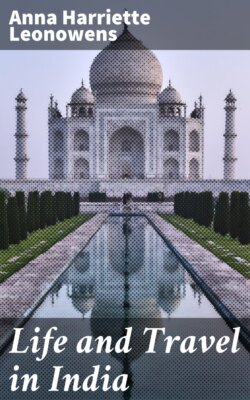Читать книгу Life and Travel in India - Anna Harriette Leonowens - Страница 6
На сайте Литреса книга снята с продажи.
Footnote
ОглавлениеTable of Contents
[1] The name Mahratta is applied to all the Indo-European races who dwell in that portion of India extending from the Arabian Sea on the west to the Satpura Mountains in the north, to which in ancient times was given the Sanskrit name of Maharashtra, or "the good country." The Mahrattas are Hindoos, divided like them into four castes—the Brahmans, priests and professors; the Kumbis, cultivators of the soil; the Rajpoots, or warriors; and the Sudras, or menials. The Mahratta Brahmans are remarkable for the high physical, intellectual, and moral qualities of that caste. Their language, a fine sonorous and flexible tongue, is a dialect of the Sanskrit, called Mahratti.
[2] Pieces of money each of the value of one-fourth of a penny.
[3] The Jains, a very curious sect found in India proper to-day, and known only to the learned in Europe as the sole representatives in Hindostan of the once-numerous adherents to the tenets of Buddhism in that region, hold an intermediate place between Buddhists and Brahmans, but approach more closely to the Buddhists. They hold that Mahavira the hero, their greatest teacher, and the last of a number of deified spiritual legislators called by them Tirthankaras, was the preceptor of the great Gautama, the Buddha, whose followers embrace nearly three-fourths of the human race even to-day. They have, like the Brahmans, castes, and abstain most rigorously from flesh of all kinds. But, on the other hand, like the Buddhists of Siam, Burmah, Japan, etc., they disavow the sacredness of the Vèdas and the Hindoo gods, but in their place worship twenty-four sanctified legislators or Tirthankaras.
[4] The descendants of the early Portuguese settlers who have intermarried with the Hindoos and other castes of India, and now form a very large portion of the population of Bombay and Goa.
